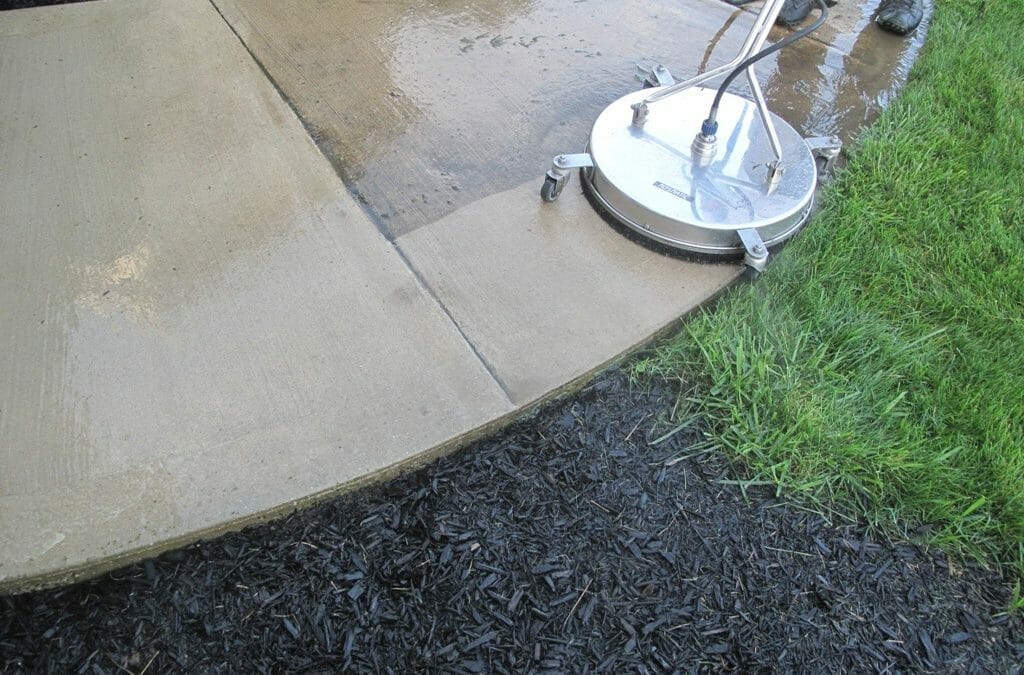
Concrete is tough, right? It’s used for sidewalks, driveways, patios, and even entire buildings. So, you might assume it can handle anything—including a good blast from your pressure washer. But here’s the kicker: Yes, pressure washing can actually damage concrete if you’re not careful. 😬
While concrete is durable, it’s also porous and vulnerable to high-pressure erosion. Let’s explore what causes damage, how to avoid it, and the best ways to safely clean your concrete surfaces.
🔍 Why Concrete Gets Damaged from Pressure Washing
Despite being solid and heavy-duty, concrete has a lot going on beneath the surface. It’s made of sand, gravel, water, and cement—which means it:
- Has small air pockets (porous)
- Can contain soft or weak spots
- May have cracks or seams already forming
When water under extreme pressure (2,500–4,000 PSI) hits the surface, it can:
- Etch or scar the surface
- Chip or pit soft areas
- Exaggerate existing cracks
- Strip sealant or finish
- Create inconsistent textures or streaks
So while pressure washing can make concrete look brand new, it can also leave it permanently scarred if done incorrectly. 😓
🚫 Common Mistakes That Lead to Concrete Damage
Here are a few things you should avoid if you want to keep your concrete safe:
- Using too much pressure – 4,000+ PSI can gouge the surface
- Spraying too close – Holding the wand within 2–4 inches is too aggressive
- Using a 0° or 15° nozzle on a standard wand
- Staying in one spot too long
- Skipping a pre-soak or cleaner, which makes you rely on pressure alone
Even seasoned DIYers make these mistakes when trying to speed up the job.
✅ How to Pressure Wash Concrete Safely
Concrete can handle pressure washing—if you do it right. Here’s a safe method:
1. Sweep the Area
Get rid of debris, leaves, rocks, and dirt before spraying.
2. Use the Right Equipment
- PSI: Stick to 2,500–3,000 PSI
- Nozzle: Use a 25° (green) or 40° (white) tip
- Wand Distance: Keep the wand at 8–12 inches from the surface
3. Pre-Treat Tough Stains
Apply a concrete-safe cleaner to:
- Oil spots
- Rust stains
- Mildew or algae
Let it soak for 10–15 minutes and gently scrub if needed.
4. Spray in Even Strokes
Work in horizontal or vertical lines, overlapping slightly. Avoid “scribbling,” which causes streaks and uneven cleaning.
5. Rinse and Let Dry
Don’t let soap or detergent dry on the surface. Rinse thoroughly and allow the concrete to dry for several hours before sealing or walking on it.
Browse Amazon Here For Top Rated Power Washers And Accessories
🌀 Consider Using a Surface Cleaner
A surface cleaner is a round attachment that connects to your pressure washer. It:
- Maintains even pressure
- Prevents stripes and swirl marks
- Covers more area quickly
If you’re cleaning large driveways or patios, this is a game changer. 💥🧼
🧪 Should You Seal the Concrete After Cleaning?
Yes—especially after pressure washing.
Sealants protect your concrete from:
- Water intrusion
- Oil stains
- UV damage
- Freeze-thaw cracking in colder climates
Apply a concrete-specific sealer 24–48 hours after washing. This helps lock in your hard work and keeps surfaces cleaner longer.
🧠 Final Thoughts
Concrete may be strong, but it’s not indestructible. Pressure washing is a powerful tool—when used with care. 💡🧽
To recap:
- ✅ Use the right nozzle and keep the wand at a safe distance
- ⚠️ Avoid too much PSI or staying in one spot
- 💧 Pre-treat stains instead of relying only on pressure
- 🌀 Use a surface cleaner for even results
- 🛡️ Seal your concrete afterward for long-term protection
Done correctly, pressure washing can restore your concrete’s color, remove years of grime, and boost curb appeal—all without a scratch. 🏠✨
Browse Amazon Here For Top Rated Power Washers And Accessories






